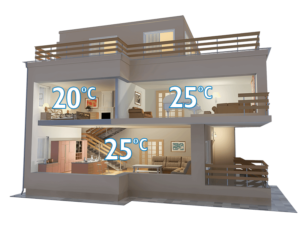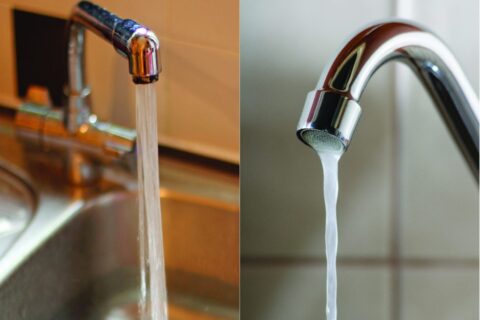7 Key Benefits of an AC Zoning System
An AC zoning system offers comfort and efficiency that a traditional system simply can’t match. Instead of cooling your entire home, it allows you to target specific areas. This means you can save energy and money while enjoying a perfectly climate-controlled environment with new HVAC systems, zoned HVAC systems, temperature zones, and zone heating.
No more fighting over the thermostat or dealing with hot spots in your house. With an AC zoning system, each room can have its own temperature settings. This flexibility enhances comfort for everyone. You’ll notice the difference in your utility bills too. Lower energy consumption in the hvac system leads to savings that add up over time with zone heating and an hvac zoning system. Embrace the benefits of an AC zoning system and transform how you experience indoor climate control.
Key Takeaways
-
AC zoning systems allow you to control temperatures in different areas of your home, providing comfort where you need it most.
-
To get the most out of your zoning system, assess your home layout and determine the number of zones that will work best for your needs.
-
Use smart thermostats to monitor and control temperatures efficiently, ensuring each zone is set to the preferred comfort level.
-
Consider installing an AC zoning system if you have rooms that experience different temperature needs, like a sunny living room versus a shaded bedroom.
-
Enjoy energy efficiency and cost savings by only cooling or heating the areas you use, which can lead to lower utility bills.
-
Keep in mind that professional installation and regular maintenance are crucial for optimal performance of your zoning system.
Understanding AC Zoning Systems
Definition
An AC zoning system is a method used in heating and cooling. It divides a home into different zones or areas. Each zone can have its own temperature control. This system enhances home comfort through zone heating by allowing tailored HVAC zoning climate settings for each area.
Zoned air conditioning systems use dampers in the ductwork. These dampers open or close to direct airflow. Homeowners can then adjust temperatures based on specific needs.
Traditional vs. Zoned Systems
Traditional HVAC systems cool or heat an entire house uniformly, unlike zone heating. They work on a single thermostat, controlling the whole space at once. This often leads to uneven temperatures. Some rooms may be too hot while others are too cold.
Zoned systems differ significantly. They employ multiple thermostats for different areas. Each zone operates independently through hvac zoning, ensuring balanced comfort throughout the house. For example, a zoned HVAC system can keep bedrooms cooler at night while maintaining warmth in living areas during the day.
Personalized Temperature Control
Personalized temperature control is a key benefit of zoned HVAC systems. Homeowners can set different temperatures for each room based on usage patterns. For instance, a family may prefer zone heating for a cooler setting in bedrooms during sleep hours with hvac zoning.
This flexibility leads to increased comfort and energy efficiency. Unused rooms do not need to be heated or cooled as much with zone heating and hvac zoning, reducing energy waste. Ductless zoning systems are particularly effective for this purpose. They allow for individual room control without extensive ductwork.
Benefits of Zoning Systems
-
Energy Efficiency: Zoned systems reduce energy consumption by targeting only occupied spaces.
-
Enhanced Comfort: Each room can maintain its desired temperature.
-
Cost Savings: Lower energy bills result from reduced usage in unoccupied areas.
-
Improved Air Quality: Zoning can help manage humidity levels better.
How AC Zoning Works
Multiple Thermostats
Thermostats play a crucial role in an AC zoning system. Each zone in a home can have its own thermostat. This allows for precise temperature control in different areas. For example, the living room may need to be cooler than the bedrooms at night due to zone heating.
Homeowners can set each thermostat according to their comfort levels. This means that if one family member prefers a cooler room, they can adjust their zone without affecting others. The use of multiple thermostats for zone heating leads to better energy efficiency. It reduces the need to cool or heat unused spaces.
Dampers Control Airflow
Dampers are essential components of an AC zoning system. They regulate airflow to specific areas of the home. When a thermostat signals a change in temperature for zone heating, dampers open or close accordingly. This directs air only where it is needed.
For instance, if the kitchen is warm and needs cooling, the damper for that zone opens. Meanwhile, dampers for other rooms may close to maintain their temperatures. This targeted airflow ensures that energy isn’t wasted on unoccupied areas.
Adjusting Temperatures
Adjusting temperatures based on occupancy is another benefit of an AC zoning system. Smart technology can enhance this process further. With smart thermostats, homeowners can program settings based on when rooms are used.
For example, during the day, people may occupy only certain rooms. The system can lower the temperature in unused areas while keeping occupied zones comfortable. At night, it can switch back to ensure everyone sleeps well.
This flexibility not only improves comfort but also saves energy costs. Homeowners notice a decrease in utility bills over time due to efficient cooling and heating practices.

Determining the Number of Zones
Assess Layout
Identify the layout of your home first. Each space can serve as a potential zone. Consider how rooms connect and flow into one another. Open floor plans might require fewer zones, while segmented layouts may need more.
Room size plays a crucial role in zoning decisions. Larger rooms often need their own temperature zones. Smaller spaces may share zones effectively. Evaluate high-usage areas, like living rooms or kitchens, for separate zones.
Usage Frequency
Frequency of use matters when determining zones. Rooms that are used daily should have their own heating zones. This ensures comfort throughout the day. Less frequently used spaces can share a zone to save energy.
Consider seasonal usage too. A guest room may not need its own zone year-round. Instead, it can share with nearby areas. This approach keeps costs down while maintaining comfort when needed.
Sunlight Exposure
Sunlight exposure influences temperature in different rooms. South-facing rooms typically receive more sunlight. These areas may require less heating or cooling compared to shaded rooms.
Evaluate how sunlight affects each space. A sunlit room might feel warmer in summer and cooler in winter. Adjusting the zoned system based on this can enhance comfort and efficiency.
Household Needs
Evaluate the needs of all household members next. Different people have varying preferences for temperature. Some prefer cooler spaces while others like warmth.
Incorporating these preferences into your zone system is vital. For instance, a teenager may want a cooler environment for sleeping. Meanwhile, an elderly family member might prefer warmth in their living area.
Major Household Zones
Identify major household zones to optimize comfort. Common zones include living areas, bedrooms, and home offices. Each can have tailored settings for maximum satisfaction.
Creating distinct zone systems allows flexibility in temperature control. For example, you could set the living room cooler during the day and warmer at night.
Multiple Dampers
Using multiple dampers helps regulate airflow between zones effectively. Dampers control how much air flows into each zone, ensuring balanced temperatures throughout your home.
This system reduces energy waste by targeting only occupied areas. It also allows for personalized comfort levels across various parts of your house.
Monitoring and Controlling Temperatures
Smart Thermostats
Smart thermostats play a crucial role in managing temperatures effectively. They allow users to set specific temperatures for different areas in their homes. This feature is vital for zone heating systems, which create multiple temperature zones. Each zone can have its own thermostat, enabling precise control over heating and cooling.
With smart technology, these thermostats learn user preferences over time. They adjust automatically based on daily routines. This automation helps maintain comfort while saving energy.
Remote Access
Remote access is another significant advantage of modern thermostat systems. Homeowners can adjust temperatures from anywhere using smartphones or tablets. Whether at work or on vacation, users can ensure their home stays comfortable.
This flexibility is especially beneficial during extreme weather conditions. For instance, if a cold front hits unexpectedly, users can raise the temperature before arriving home. This capability enhances comfort and can prevent issues like frozen pipes in winter.
Regular Monitoring
Regular monitoring of HVAC systems is essential for maintaining desired comfort levels. Users should check their system’s performance periodically. This practice helps identify any irregularities in temperature control.
Monitoring also includes checking the functionality of dampers in a zone heating system. Dampers regulate airflow to different zones, ensuring even distribution of heat or cool air. If dampers malfunction, certain areas may become too hot or too cold.
Homeowners should schedule routine maintenance for their HVAC systems. Regular checks can improve efficiency and extend the system’s lifespan. Technicians can pinpoint issues that may affect temperature control.
Benefits of Multiple Temperature Zones
Creating multiple temperature zones offers various benefits. It allows for personalized comfort throughout the home. Family members can set different temperatures based on their preferences.
Energy savings are another advantage of this zoning approach. By only heating or cooling occupied spaces, homeowners reduce energy waste. This efficiency leads to lower utility bills over time.
Moreover, a zone heating installation provides greater control over indoor climates. Different rooms often have varying heating needs due to factors like sunlight exposure and insulation quality. With proper zoning, each room can achieve optimal conditions.
When to Use AC Zoning
Multi-Level Homes
Zoned air conditioning is ideal for multi-level homes. Each floor often experiences different temperatures. The upper floors can get hotter in summer, while basements might stay cooler. HVAC zoning allows homeowners to control temperatures on each level separately. This leads to better comfort and energy efficiency.
For example, a three-story house can have different settings for each floor. The top floor may need more cooling during hot months. Meanwhile, the ground floor may require less cooling or heating. By using zoned HVAC, families can avoid wasting energy on spaces that do not need it.
Varying Heating and Cooling Needs
Homes with varying heating and cooling needs across rooms benefit greatly from HVAC zones. Some rooms may receive more sunlight than others. Others might have poor insulation, leading to colder temperatures. Zoning helps balance these differences efficiently.
In a home office with large windows, the temperature may rise quickly. A zoned system can cool this room more effectively without overcooling adjacent spaces. This targeted approach saves energy and improves comfort for everyone in the home.
Frequent Guest Visits
Implementing zoning is also wise for homes that frequently host guests. Rooms used for entertaining may need different settings compared to private areas. Guests might prefer warmer or cooler environments based on their preferences.
By utilizing zoned heating and cooling, hosts can ensure comfort for everyone. For instance, a guest bedroom can be set to a comfortable temperature while keeping other areas at a lower setting when not in use. This flexibility enhances the overall experience for visitors and reduces energy costs.
Changing Occupancy
Zoning systems are beneficial in homes with changing occupancy patterns. Families often have different numbers of people at home throughout the week. Some days may see full occupancy, while others may be quieter.
With HVAC zoning, homeowners can adjust temperatures according to current needs. During busy weekends, all rooms can be comfortably cooled or heated. On quieter weekdays, less-used areas can be set to conserve energy without sacrificing comfort elsewhere.
Key Benefits of AC Zoning
Comfort Control
Personalized temperature settings enhance comfort in each room. Different rooms often have different heating and cooling needs. For instance, bedrooms may require cooler temperatures for sleep, while living areas might need to be warmer during family gatherings.
With an AC zoning system, each area can be adjusted to meet specific preferences. This flexibility leads to a more enjoyable living environment for everyone in the household. Family members can enjoy their ideal climate without compromise.
Reduced Conflicts
Thermostat conflicts often arise in homes with multiple occupants. One person may want it cooler, while another prefers warmth. These disagreements can lead to frustration and discomfort.
AC zoning solves this issue by allowing individual control over temperatures. Each zone can be set according to personal preference. This feature reduces tension among family members and creates a more harmonious atmosphere at home.
Consistent Temperatures
Maintaining consistent temperatures throughout the home is another significant benefit of AC zoning. Traditional systems might cool or heat only one area effectively, leaving others uncomfortable.
Zoning systems distribute air evenly across all zones. This results in fewer hot or cold spots in the house. Homeowners can enjoy a uniform climate, making every room comfortable year-round.
Consistent temperatures can lead to energy savings. When each area is kept at the desired temperature, the system operates more efficiently. This efficiency can lower energy bills over time.
Energy Efficiency
Energy efficiency is critical in today’s world. An AC zoning system helps optimize energy use by only cooling or heating occupied spaces. This targeted approach reduces unnecessary energy consumption.
For example, if a family spends most of their time in the living room, they can focus on cooling that area instead of the entire house. Unused rooms can remain at a higher temperature without impacting comfort where it matters most.
Increased Property Value
Investing in an AC zoning system can also increase property value. Many homebuyers look for features that enhance comfort and efficiency. A well-installed zoning system can make a home more appealing on the market.
Homeowners who prioritize comfort and efficiency stand out to potential buyers. They can highlight the benefits of personalized temperature control and energy savings during showings.
Energy Efficiency and Cost Savings
Energy Savings
AC zoning systems provide significant energy savings. The U.S. Department of Energy reports that homeowners can save up to 30% on their energy bills by using these systems. Instead of cooling or heating the entire house, zoning allows for targeted adjustments. This means rooms that are not in use do not need to be conditioned.
By focusing on specific areas, such as bedrooms or the downstairs, energy flow becomes more efficient. Homeowners can set different temperatures for each zone based on their needs. For example, keeping the upstairs cooler during summer nights can enhance comfort while saving energy.
Cost Reduction
Using an AC zoning system leads to a noticeable reduction in utility costs. Traditional HVAC systems often run constantly to maintain a set temperature throughout the entire home. This method wastes energy in unoccupied spaces. Zoning systems eliminate that waste.
When only necessary areas receive heating or cooling, utility bills decrease. Homeowners will see this reflected in their monthly statements. Over time, these savings add up significantly, making it a smart financial decision.
Comfort Control
Comfort in a home is paramount. Zoning provides the ability to control temperatures according to personal preferences. Some family members may prefer a cooler bedroom, while others enjoy warmth in the living room.
This flexibility improves overall satisfaction with indoor environments. It also reduces the likelihood of disputes over thermostat settings. With individual control, everyone can feel comfortable in their own space.
Reduced Maintenance Costs
Investing in an AC zoning system can lead to lower long-term maintenance costs. Traditional HVAC units often require frequent repairs due to overuse. Running a system at full capacity puts stress on components, leading to potential breakdowns.
Zoned systems operate more efficiently and typically experience less wear and tear. This results in fewer repair calls and longer equipment life. Homeowners benefit from reduced HVAC maintenance costs over time.
Installation and Maintenance Considerations
Typical Costs
Installing a zoned HVAC system can vary in cost. The average price ranges from $2,000 to $4,500. This depends on the size of the home and the complexity of the installation. Additional costs may arise if ductwork needs modification or if new equipment is required. Traditional HVAC setups often lack this zoning capability, making it necessary to invest more upfront for these systems.
Homeowners should also consider the long-term savings from energy efficiency. Reduced energy bills can offset installation costs over time. It’s essential to evaluate the right fit for your home to maximize these benefits.
Maintenance Needs
Zoning systems do not require additional maintenance beyond standard HVAC care. Regular checks on filters, ducts, and equipment are still necessary. Homeowners should schedule annual inspections with professionals. These inspections ensure that all components function correctly and efficiently.
Keeping up with regular maintenance helps avoid costly repairs later. It also extends the lifespan of the system. Zoning systems maintain their performance without needing specialized upkeep.
Selecting Professionals
Choosing qualified professionals for installation is vital for optimal performance. Look for contractors who specialize in zoned HVAC systems. They should have experience and positive reviews from previous clients.
Ask potential installers about their certifications and licenses. A good contractor will provide proof of insurance as well. Request multiple quotes to compare prices and services offered.
Check references before making a decision. Speaking with past clients can give insight into their workmanship and reliability.
Consider asking about warranties on equipment and labor as well. A solid warranty can protect your investment in case issues arise after installation.
Final Remarks
AC zoning systems offer flexibility, comfort, and energy savings for your home. By allowing you to control temperatures in different areas, you can create a personalized environment while reducing energy costs. This system is perfect for homes with varying heating and cooling needs, ensuring everyone stays comfortable.
Investing in an AC zoning system is a smart move for your comfort and wallet. Take the next step towards a more efficient home by exploring your options today. Don’t wait—enhance your living space and enjoy the benefits of zoned climate control now!
Frequently Asked Questions
What is an AC zoning system?
An AC zoning system allows you to divide your home into different areas or zones, each with its own temperature control. This enhances comfort and energy efficiency.
How does AC zoning work?
AC zoning uses dampers in the ductwork to direct airflow to specific zones. Each zone has a thermostat, allowing for personalized temperature settings.
What are the benefits of using AC zoning?
The key benefits include improved comfort, energy efficiency, cost savings on utility bills, and extended HVAC system lifespan by reducing wear and tear.
When should I consider installing an AC zoning system?
Consider AC zoning if you have a large home, multiple stories, or rooms with varying heating and cooling needs. It’s ideal for enhancing comfort and efficiency.
Is installation of an AC zoning system complicated?
Installation can be complex and typically requires professional help. Proper assessment of your home’s layout and existing HVAC system is crucial for optimal performance.
How can I maintain my AC zoning system?
Regular maintenance includes changing air filters, checking dampers, and ensuring thermostats function correctly. Schedule annual professional inspections for best results.
Will an AC zoning system save me money?
Yes, by allowing targeted heating and cooling, an AC zoning system can significantly reduce energy consumption and lower your utility bills over time.


